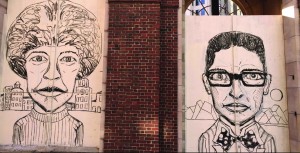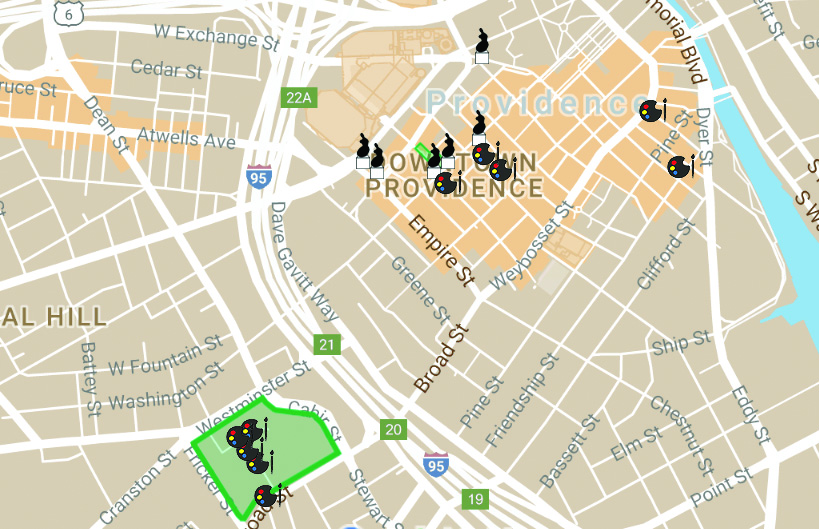The Avenue Concept is a non-profit organization that has gone from channeling and championing street art to becoming the prime mover for public art in our state’s Creative Capital City. Murals and sculpture installations – roughly 109 around the city – have bloomed as a result of their efforts and the city’s collaboration with artists and arts organizations. We talked with Avenue Concept founder Yarrow Thorne about the state of public art in PVD and their latest installation.
“The city is trying to figure out what it means to interact with public art. They’ve created a lot of policy around it recently, and they’re working on the implementation. It’s relatively simple with  plywood and paint [see below], but there are still a lot of proposals and approvals that come into play,” says Thorne.
plywood and paint [see below], but there are still a lot of proposals and approvals that come into play,” says Thorne.
“You want people to talk about work, and you want people, at some point, to be able to talk about why they don’t like something. It’s not about ‘I’m right and your wrong;’ it’s about, ‘I don’t like it because of the colors or the pattern or the content.’ That turns into a story.”
“Right now there’s a lot of lack of understanding and consideration in our community and people are very quick to respond to things, sometimes without background or context. People will yell at you for a while, and when you tell them the backstory and considerations, then they go, ‘Oh, yeah.’”
His greatest wish for the city in the next few years? “We’d most like the city to consider what it wants to be in relation to public art,” says Thorne. “How do you represent all the interests of a diverse community? We’re not trying to be controversial. We’d like to be. We’d like to always inspire more conversation about what people like and don’t like about any given piece of art. That’s what great art should do – inspire exchanges of ideas. But right now, we’re just trying to get work out there and refine the processes and systems.
“I would love for them to decide what they really want. A lot of the federal and other funding goes toward preserving Providence as an historical city. The [Providence] Preservation Society like what we’re doing, and is great to work with, but there are a lot of regulations – you can’t paint on exposed brick, or certain historic structures. Our feeling is that Providence can be an historic city, but also have striking contemporary public art. The contrast draws more attention to the historic, and is refreshing. So much of art is about contrast, and about unexpected surprises. You can have the modern and the historic alternating, and the historic stands out more and is more valued in contrast.
“[Some] preservation-oriented organizations were against modern mural installations, but once they were up we’ve been having great conversations about how, with these pieces, there’s contrast. It makes the historic aspect of the city stand out more. And it brings some people into downtown who might otherwise not have gone, and they experience both sides. You want things to stand out. If there’s a bright blue wall all of a sudden, maybe you notice the granite and the historic detail of the building next to it that much more, because now it’s not all the same. We don’t need to compromise the historic – there are plenty of buildings downtown that are cinderblock or stucco or plywood or whatever, that are not historic or brick.”
 The Avenue’s latest installation is an example of living city art, modernism taking advantage of available space. The artist is Bert Crenca, the founder of AS220. Says Thorne, “He’s started his installation downtown this morning [Sep 1]. It’s a way for us to work with a local artist and help them expand out of the studio and into the public sphere. Two years ago it was JJ [] and he discovered paint chips and created a whole new body of work. Last year it was Forest [] and he brought to life a series of 3D painted sidewalks in the Mount Pleasant neighborhood and created a set of boxes that have since been incorporated into the curricula at RISD. This year, Bert is using paint markers and found items, graffiti and street art techniques to bring his doodles to much larger-than-life installations. The paint markers are a new technology that allows the paint to flow more evenly than with a brush, but last much longer than a sharpie or traditional marker. Just like working with paint, you can layer it and paint over things, but you have a lot more control and can move faster. He blocked out two full, 12-foot-high figures today. It’s going to be five figures on five panels. His body of work right now is about all the different people in the world and their different backgrounds – they’re not portraits of people, they’re interpretations of how people think of other types of people in the world … He has a robot, a lot of patterns and accessories. It’s hard to explain until you go see it. It’s been a lot of fun for me working with Bert. And with the other local artists we’ve engaged with – I learn a lot, they end up pushing their boundaries through the process. It’s great.”
The Avenue’s latest installation is an example of living city art, modernism taking advantage of available space. The artist is Bert Crenca, the founder of AS220. Says Thorne, “He’s started his installation downtown this morning [Sep 1]. It’s a way for us to work with a local artist and help them expand out of the studio and into the public sphere. Two years ago it was JJ [] and he discovered paint chips and created a whole new body of work. Last year it was Forest [] and he brought to life a series of 3D painted sidewalks in the Mount Pleasant neighborhood and created a set of boxes that have since been incorporated into the curricula at RISD. This year, Bert is using paint markers and found items, graffiti and street art techniques to bring his doodles to much larger-than-life installations. The paint markers are a new technology that allows the paint to flow more evenly than with a brush, but last much longer than a sharpie or traditional marker. Just like working with paint, you can layer it and paint over things, but you have a lot more control and can move faster. He blocked out two full, 12-foot-high figures today. It’s going to be five figures on five panels. His body of work right now is about all the different people in the world and their different backgrounds – they’re not portraits of people, they’re interpretations of how people think of other types of people in the world … He has a robot, a lot of patterns and accessories. It’s hard to explain until you go see it. It’s been a lot of fun for me working with Bert. And with the other local artists we’ve engaged with – I learn a lot, they end up pushing their boundaries through the process. It’s great.”
The installation is on Weybosset St, and takes advantage of the plywood boarding over windows in an unused building at [address]. It should be a few weeks worth of work, so when you read this you can still go down there and see the work evolve.
“We want our artists not only to paint, but to interact with people,” Thorne explains. “It might delay the process a little, but it’s also really the reason for the work. We want them to talk to passersby, and talk about the work.”
You can catch Bert on sunny days for a little while … stop by and harass him at your leisure!



